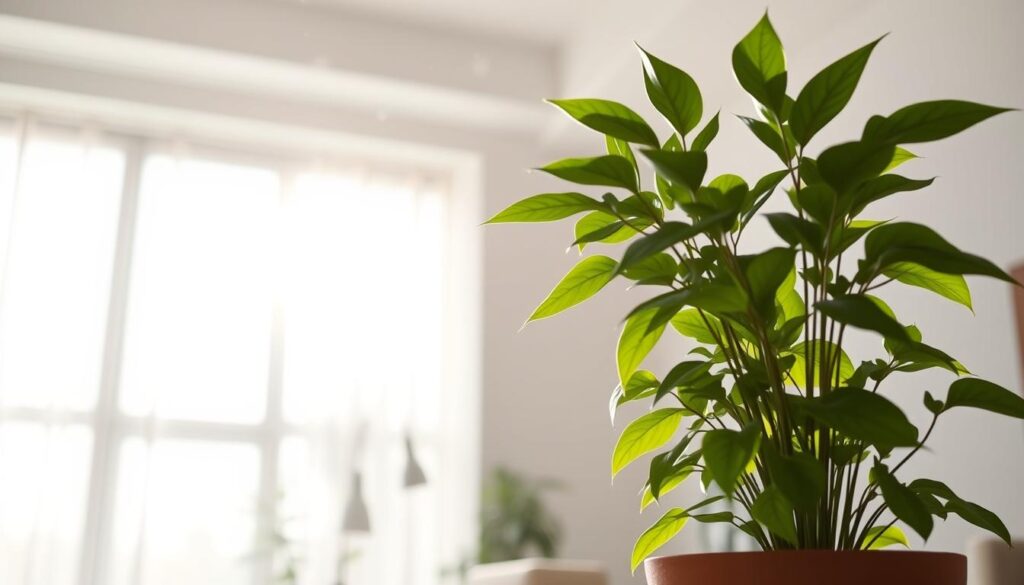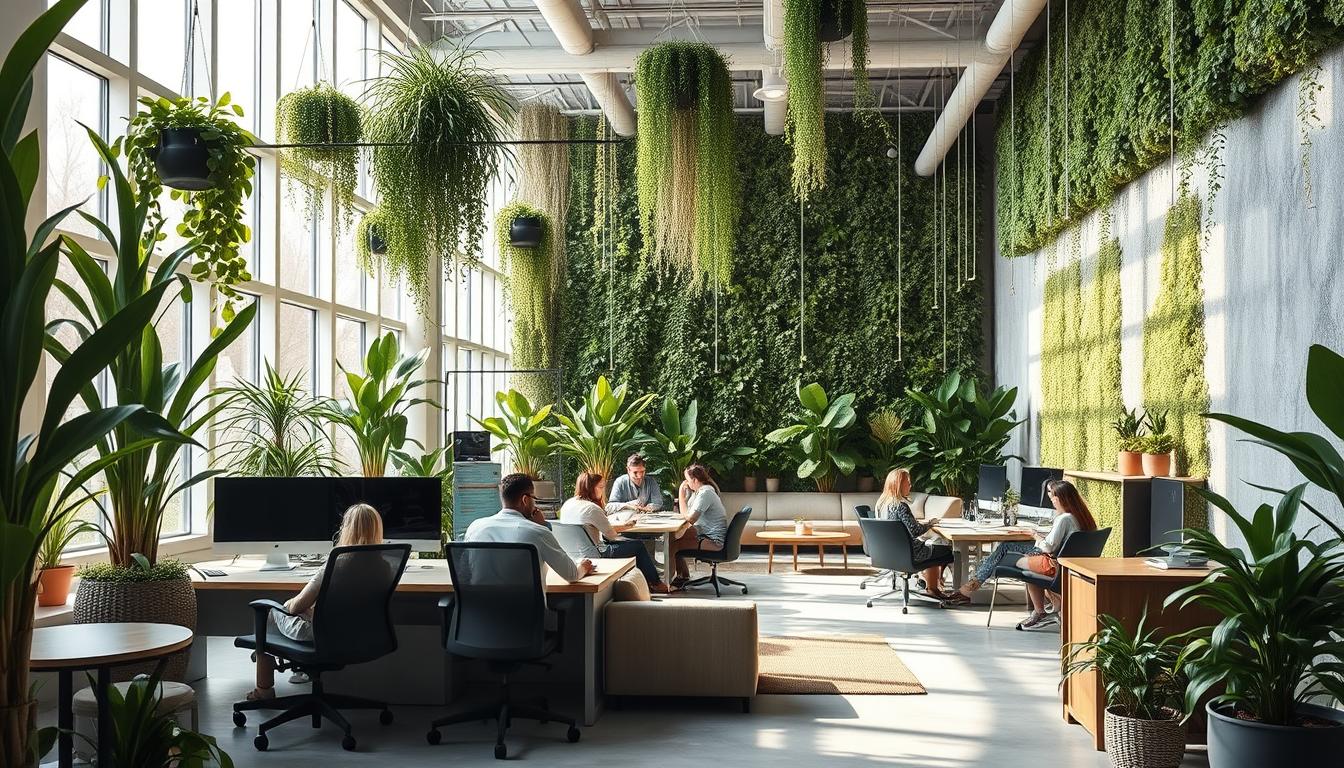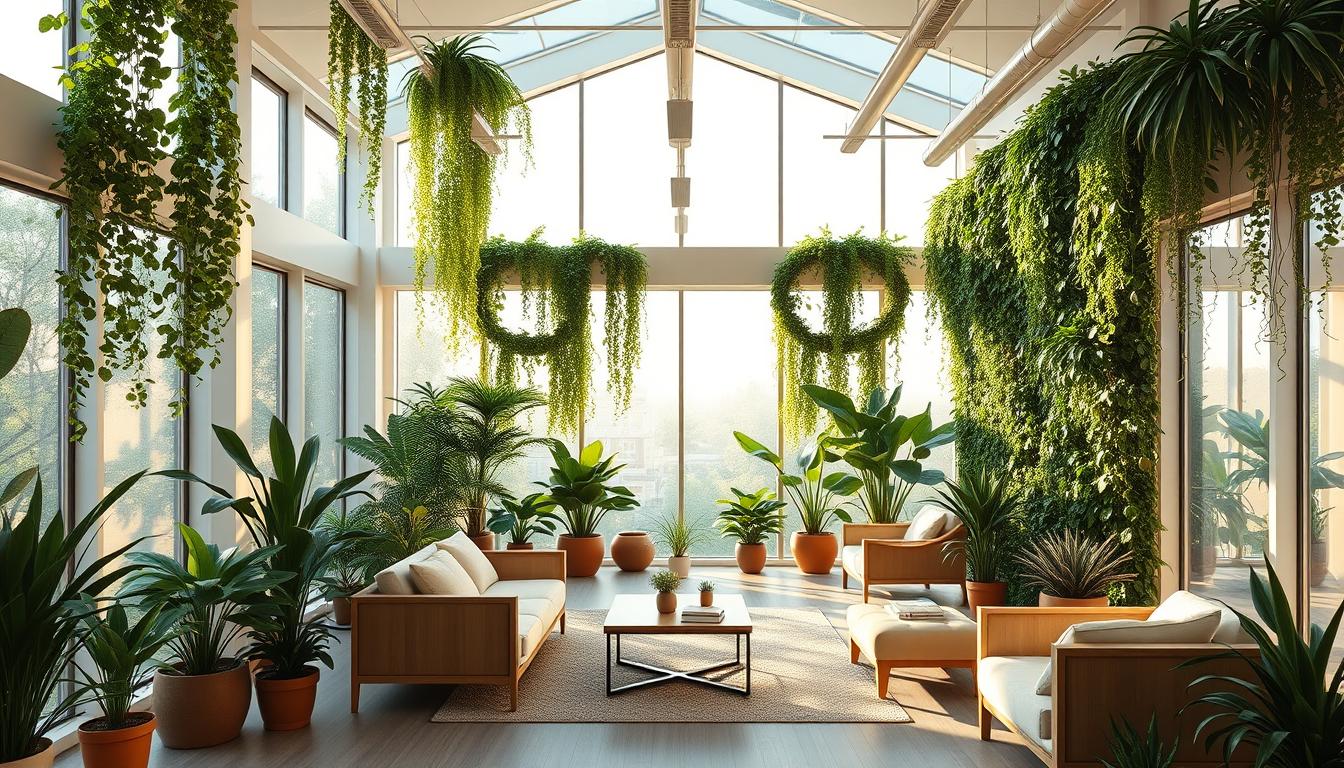Now more than ever, we want cleaner air inside our homes and offices. Learning about plant-assisted air circulation is key. It’s a natural way to make indoor air better and boost the feel of our green spaces. By using smart methods for moving air around, we can make any space, big or small, healthier and more welcoming. Let’s dive into cool ways and tools that use nature to freshen up our indoor environments.
The Importance of Indoor Air Quality
Good indoor air quality is vital for our health and comfort. Poor air inside can cause health problems, especially for our lungs. Things like dust, mold, and harmful chemicals can build up and cause allergies or other issues.
Having clean air in our homes means we need good airflow. This helps lower the amount of bad stuff in the air. By keeping the air fresh, everyone living there feels better. It’s important to take steps to improve air movement for a healthier space.

Understanding Plant-Assisted Air Circulation
Plant-assisted airflow is key for a healthy indoor space. It combines the natural abilities of plants with air moving systems to improve air quality. Understanding this can help people create a better environment for both plants and themselves.
Definition and Mechanism
Plant-assisted airflow mixes natural ventilation with indoor plants. Plants boost air movement by releasing moisture, which levels out humidity. Pairing this with fan-based air movement makes the air circulate better. This helps plants flourish and makes indoor areas nicer to be in.
Benefits of Natural Airflow
There are many good things about airflow in a plant-aided setting. Better humidity from plants helps them grow strong. Cleaner air is another plus, as it makes breathing easier for people. Plus, a balanced indoor climate can make everyone feel better and more focused. Spaces with good airflow keep both plants and people happy.
How Greenhouses Utilize Air Circulation
Greenhouses need good air flow to keep plants healthy. Horizontal Airflow (HAF) fans are key for this. They spread air evenly, making sure all plants get the warmth and moisture they need. This creates the perfect place for plants to grow.
The Role of HAF Fans in Greenhouses
HAF fans keep the air moving well in greenhouses. Brands like J&D Manufacturing make these fans. They help cut down on heating costs by moving warm air around. By doing this, they keep the temperature steady which is vital for the plants’ health. HAF fans are very important for growing plants today.
Economic Benefits of Efficient Air Movement
Using HAF fans well can save a lot of money for greenhouses. They make heating more efficient, reducing costs. This also means plants grow better, leading to more crops. With better use of resources and less waste, profits go up. Studies prove that these fans really make a difference financially.
Introducing J&D Manufacturing’s Green Breeze Fan
The J&D Green Breeze Fan shines for being versatile and energy-saving. Aimed at greenhouses, it boosts airflow and keeps air fresh for plants indoors. Knowing its fan specs helps growers pick the right tool for healthier plants.
Key Features and Specifications
With a 24-inch width, this fan is both powerful and safe, thanks to its Open-Front Guard. You can change the speed to meet your needs. This makes it great for different growing conditions.
- Corrosion-resistant materials for durability
- Direct drive design minimizes maintenance requirements
- Simple installation process enhances user experience
Energy-Efficient Options for Air Circulation
Saving energy is key for sustainable urban farms. The Green Breeze Fan uses less power but still moves a lot of air. It’s perfect for growers who care about the planet. With these fans, indoor gardens can be more eco-friendly.
Optimizing Plant Health with Air Movement
Improving plant health with the right air movement is key for strong growth. Adjusting fan speed is a vital trick. It helps at different growth times. By knowing how plants react to air, growers can make better spaces. These spaces fight off stress well.
Adjusting Fan Speed for Plant Growth
The correct fan speed makes plants healthier. Slow speeds give a soft wind, helping roots get strong and plants tough in early stages. This method improves how plants take in nutrients and get ready for selling. It’s important to match fan speed with the plant’s growth stage.
- Seedlings do well in calm, low-speed air.
- Vegetative plants need a bit faster air to grow strong.
- Flowering plants benefit from higher speeds for better pollination.
Hardening Plants Before Shipping
Getting plants ready for transport is crucial for their survival. Fans help by slowly getting them used to new conditions. This reduces the shock plants feel when moved. A good pre-shipment plan includes managing air to harden plants well.
- Slowly increase fan speeds over two weeks.
- Keep an eye on moisture to avoid drying out.
- Set fan timers for regular air during hardening.
Enhancing Airflow with Misting Kits
Misting kits are vital in controlling humidity, especially where it’s crucial for the health of plants. These systems boost airflow and make the perfect growing conditions. By using misting systems, growers see better humidity which helps plants and the air around them.
How Misting Systems Improve Indoor Climate
Adding misting kits to your air system balances moisture and airflow. This balance lets plants get just the right amount of humidity without overwatering. It also lowers stress on plants and cleans the air, which is why indoor gardeners love it.
Available Kits for Different Fan Models
There are many misting systems that fit different fans. You’ll find heavy-duty kits for big greenhouses and smaller ones for homes. Each kit usually comes with:
- Misting nozzles for even spray
- Efficient pumps
- Hose and fittings for simple setup
The cost depends on the features and extra gear, giving growers options for their setup. This way, they can improve the air for different uses.
Applications of Plant-Assisted Air Circulation
Using plants to help with air circulation is not just for greenhouses anymore. This method can make indoor gardens better by giving plants the air they need to grow well. It can change both big farms and small city gardens for the better.
From Greenhouses to Indoor Gardens
What we learn from greenhouses can also help smaller gardens inside. By placing fans wisely and using the natural flow of air, indoor gardens can get better. Here are some ways to do this:
- Incorporating oscillating fans to mimic outdoor breezes.
- Utilizing ventilation openings to encourage cross breezes.
- Implementing humidity and temperature control systems to maintain ideal conditions for indoor plants.
Benefits for Residential Settings
Improving air flow at home has both health perks and makes your home look better. Using these techniques lets indoor plants thrive and boosts the air quality. Important benefits are:
- Reduction of indoor pollutants through the natural filtration properties of plants.
- Improvement of mood and focus due to the presence of greenery.
- Increased humidity, which can help alleviate respiratory issues and skin dryness.
Variable Speed Control for Customized Airflow
Good airflow in rooms depends on variable speed control. This lets you adjust airflow to meet current needs perfectly. It’s very important to find the right balance between being comfortable and saving energy. Knowing the difference between manual and automatic controls makes a big difference for users. Whether you’re into gardening or run a commercial growing operation, choosing the right fan controls makes things work better.
Manual vs. Automatic Controls
Manual controls are easy to use. You can change the fan speed yourself, which is great if you like to control things directly. On the other hand, automatic controls use sensors to adjust the fan. This means you don’t have to keep checking on it. Both options have their benefits, so you can pick what works best for your situation.
Choosing the Right Speed Control for Your Needs
When choosing speed controls, think about how you’ll use the fan system. Consider things like:
- Your preference for being involved or letting it run on its own.
- The importance of keeping the environment the same.
- How the fan control systems work.
- How easy it is to put in and look after.
Understanding these factors helps you make a smart choice on speed controls. This ensures your airflow setup meets both your needs and environmental goals. By picking solutions that fit what you’re doing, you’ll get the most out of efficiency and performance.
Environmental Benefits of Plant-Assisted Air Circulation
Using plants to help air move around gives us big wins for the environment. It makes indoor areas use less power. This is because these systems use the natural flow of air. They cut down on the need for heaters and air conditioners. So, less energy gets used. Let’s look at why these green solutions are great for a healthier planet.
Reducing Energy Consumption in Indoor Spaces
With the help of plants, air moves freely, keeping places cool or warm without extra cost. This means lower energy bills. Here are the benefits:
- Less need for air conditioners.
- Smaller carbon footprint, thanks to less fossil fuel use.
- Better energy use by placing plants in ways that help air move efficiently.
Promoting a Healthier Indoor Environment
Plants play a big role in making indoor air better. They clean the air and boost our health and happiness. Here’s what they do:
- Breathe easier with cleaner air, leading to better lung health.
- Feel better mentally with plants around you.
- Enjoy fresher air thanks to natural air flows, reducing stale air.
Common Challenges and Solutions
Indoor spaces face several air quality challenges. Ensuring good air quality is key to a healthy, productive environment. Problems like too much humidity and air that doesn’t move can hurt plant health and comfort. To fix airflow issues, a mix of tech and regular actions helps balance the air.
Addressing Air Quality Issues
Keeping an eye on air quality is very important. To tackle air quality problems, try these steps:
- Using dehumidifiers to manage humidity.
- Adding good ventilation to avoid stagnant air.
- Choosing plants that clean the air for better flow.
- Checking and changing air filters to prevent clogs.
Maintenance Tips for Optimal Performance
Fan upkeep is crucial for moving air well. Proper care keeps your systems running long and well. Here are important tips:
- Clean fan blades and housing to get rid of dust.
- Lubricate parts to keep them moving smoothly.
- Check electrical parts often to avoid issues.
- Change fan settings with the seasons for best use.
Conclusion
We’ve looked at how indoor plants and cool tools help improve the air we breathe and keep plants healthy. The article highlights how plants help with airflow and using tools like the J&D Manufacturing’s Green Breeze Fan makes it even better. Knowing this can make inside spaces much nicer.
Plant-assisted air circulation is great for homes and greenhouses. It’s clear that going green is good for us and the planet. By using the tips and tricks talked about, your home can be a healthier place. This is good for you and your plants.
Think about using these eco-friendly ideas. They’re worth it now and in the future. Starting to make your air better and plants happier begins with smart choices. It’s all about adding plant-assisted air circulation to your life.



